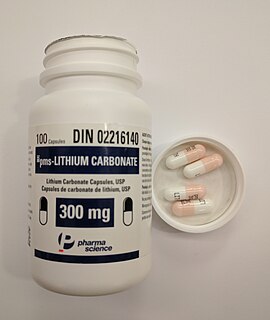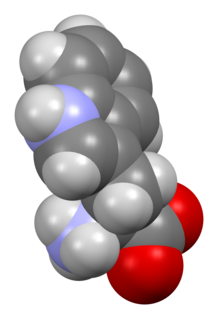Related Research Articles

Major depressive disorder (MDD), also known simply as depression, is a mental disorder characterized by at least two weeks of pervasive low mood. Low self-esteem, loss of interest in normally enjoyable activities, low energy, and pain without a clear cause are common symptoms. Those affected may also occasionally have delusions or hallucinations. Some people have periods of depression separated by years, while others nearly always have symptoms present. Major depression is more severe and lasts longer than sadness, which is a normal part of life.

A mood stabilizer is a psychiatric medication used to treat mood disorders characterized by intense and sustained mood shifts, such as bipolar disorder and the bipolar type of schizoaffective disorder.

Serotonin or 5-hydroxytryptamine (5-HT) is a monoamine neurotransmitter. Its biological function is complex and multifaceted, modulating mood, cognition, reward, learning, memory, and numerous physiological processes such as vomiting and vasoconstriction.

Serotonin syndrome (SS) is a group of symptoms that may occur with the use of certain serotonergic medications or drugs. The degree of symptoms can range from mild to severe, including a potentiality of death. Symptoms in mild cases include high blood pressure and a fast heart rate; usually without a fever. Symptoms in moderate cases include high body temperature, agitation, increased reflexes, tremor, sweating, dilated pupils, and diarrhea. In severe cases body temperature can increase to greater than 41.1 °C (106.0 °F). Complications may include seizures and extensive muscle breakdown.

Tryptophan is an α-amino acid that is used in the biosynthesis of proteins. Tryptophan contains an α-amino group, an α-carboxylic acid group, and a side chain indole, making it a non-polar aromatic amino acid. It is essential in humans, meaning that the body cannot synthesize it and it must be obtained from the diet. Tryptophan is also a precursor to the neurotransmitter serotonin, the hormone melatonin, and vitamin B3. It is encoded by the codon UGG.

Citalopram, sold under the brand name Celexa among others, is an antidepressant of the selective serotonin reuptake inhibitor (SSRI) class. It is used to treat major depressive disorder, obsessive compulsive disorder, panic disorder, and social phobia. The antidepressant effects may take one to four weeks to occur. It is taken by mouth.

Venlafaxine, sold under the brand name Effexor among others, is an antidepressant medication of the serotonin-norepinephrine reuptake inhibitor (SNRI) class. It is used to treat major depressive disorder (MDD), generalized anxiety disorder (GAD), panic disorder, and social phobia. It may also be used for chronic pain. It is taken by mouth.

Mirtazapine, sold under the brand name Remeron among others, is an antidepressant of the atypical antidepressants class primarily used to treat depression. Its full effect may take more than four weeks to occur, with some benefit possibly as early as one to two weeks. Often it is used in depression complicated by anxiety or trouble sleeping. Effectiveness is similar to other antidepressants. It is taken by mouth.

5-Hydroxytryptophan (5-HTP), also known as oxitriptan, is a naturally occurring amino acid and chemical precursor as well as a metabolic intermediate in the biosynthesis of the neurotransmitter serotonin.
Biological psychiatry or biopsychiatry is an approach to psychiatry that aims to understand mental disorder in terms of the biological function of the nervous system. It is interdisciplinary in its approach and draws on sciences such as neuroscience, psychopharmacology, biochemistry, genetics, epigenetics and physiology to investigate the biological bases of behavior and psychopathology. Biopsychiatry is the branch of medicine which deals with the study of the biological function of the nervous system in mental disorders.
Glutaric acidemia type 1 is an inherited disorder in which the body is unable to completely break down the amino acids lysine, hydroxylysine and tryptophan. Excessive levels of their intermediate breakdown products can accumulate and cause damage to the brain, but particularly the basal ganglia, which are regions that help regulate movement. GA1 causes secondary carnitine deficiency, as glutaric acid, like other organic acids, is detoxified by carnitine. Mental retardation may also occur.

Metirosine is an antihypertensive drug. It inhibits the enzyme tyrosine hydroxylase and, therefore, catecholamine synthesis, which, as a consequence, depletes the levels of the catecholamines dopamine, adrenaline and noradrenaline in the body.
A serotonin–norepinephrine–dopamine reuptake inhibitor (SNDRI), also known as a triple reuptake inhibitor (TRI), is a type of drug that acts as a combined reuptake inhibitor of the monoamine neurotransmitters serotonin, norepinephrine, and dopamine. It does this by concomitantly inhibiting the serotonin transporter (SERT), norepinephrine transporter (NET), and dopamine transporter (DAT), respectively. Inhibition of the reuptake of these neurotransmitters increases their extracellular concentrations and, therefore, results in an increase in serotonergic, adrenergic, and dopaminergic neurotransmission.

Fenclonine, also known as para-chlorophenylalanine (PCPA), acts as a selective and irreversible inhibitor of tryptophan hydroxylase, which is a rate-limiting enzyme in the biosynthesis of serotonin.

Vilazodone, sold under the brand name Viibryd among others, is a medication used to treat major depressive disorder. While it was being studied for generalized anxiety disorder, such research had stopped as of 2017. It is taken by mouth.
Scientific studies have found that different brain areas show altered activity in people with major depressive disorder (MDD), and this has encouraged advocates of various theories that seek to identify a biochemical origin of the disease, as opposed to theories that emphasize psychological or situational causes. Factors spanning these causative groups include nutritional deficiencies in magnesium, vitamin D, and tryptophan with situational origin but biological impact. Several theories concerning the biologically based cause of depression have been suggested over the years, including theories revolving around monoamine neurotransmitters, neuroplasticity, neurogenesis, inflammation and the circadian rhythm. Physical illnesses, including hypothyroidism and mitochondrial disease, can also trigger depressive symptoms.

Selective serotonin reuptake inhibitors (SSRIs) are a class of drugs that are typically used as antidepressants in the treatment of major depressive disorder, anxiety disorders, and other psychological conditions.

Lithium compounds, also known as lithium salts, are primarily used as a psychiatric medication. They are primarily used to treat bipolar disorder and treat major depressive disorder that does not improve following the use of antidepressants. In these disorders, it reduces the risk of suicide. Lithium is taken orally.
The pharmacology of antidepressants is not entirely clear. The earliest and probably most widely accepted scientific theory of antidepressant action is the monoamine hypothesis, which states that depression is due to an imbalance of the monoamine neurotransmitters. It was originally proposed based on the observation that certain hydrazine anti-tuberculosis agents produce antidepressant effects, which was later linked to their inhibitory effects on monoamine oxidase, the enzyme that catalyses the breakdown of the monoamine neurotransmitters. All currently marketed antidepressants have the monoamine hypothesis as their theoretical basis, with the possible exception of agomelatine which acts on a dual melatonergic-serotonergic pathway. Despite the success of the monoamine hypothesis it has a number of limitations: for one, all monoaminergic antidepressants have a delayed onset of action of at least a week; and secondly, there are a sizeable portion (>40%) of depressed patients that do not adequately respond to monoaminergic antidepressants. Further evidence to the contrary of the monoamine hypothesis are the recent findings that a single intravenous infusion with ketamine, an antagonist of the NMDA receptor — a type of glutamate receptor — produces rapid, robust and sustained antidepressant effects. Monoamine precursor depletion also fails to alter mood. To overcome these flaws with the monoamine hypothesis a number of alternative hypotheses have been proposed, including the glutamate, neurogenic, epigenetic, cortisol hypersecretion and inflammatory hypotheses. Another hypothesis that has been proposed which would explain the delay is the hypothesis that monoamines don't directly influence mood, but influence emotional perception biases.

Serotonin (5-hydroxytryptamine) is a monoamine neurotransmitter that plays a role in mood, eating, sleeping, arousal and potentially visual orientation processing. To investigate its function in visual orientation, researchers have utilised MDMA, or as it is commonly referred to, Ecstasy (3,4-methylenedioxymethamphetamine). MDMA is known to affect serotonin neurons in the brain and cause neurotoxicity. Serotonin has been hypothesised to be involved in visual orientation because individuals who use MDMA exhibit an increase in the magnitude of the tilt aftereffect (TAE). The TAE is a visual illusion where viewing lines in one direction, for an extended period of time, produces the perception of a tilt in the opposite direction to vertical lines subsequently viewed. This effect is proposed to occur due to lateral inhibition to orientation sensitive neurons in the occipital lobe. Lateral inhibition is where neurons that become activated to a particular orientation send inhibitory signals to their neighbouring neurons. The degree of orientation that each neuron becomes maximally excited to is referred to as the tuning bandwidth. Lateral inhibition consequently plays a pivotal role in each neuron's tuning bandwidth, such that if lateral inhibition no longer occurs, a greater number of neurons will become stimulated to the same orientation. This results in the activated neurons becoming adapted to the same orientation stimulus, if the stimulus is viewed for a period of time. As a consequence, if those neurons are subsequently 'shown' another stimulus that differs slightly in its orientation, those neurons are no longer able to achieve the same level of response as compared to other non-adapted neurons.
References
- 1 2 3 van Donkelaar EL, Blokland A, Ferrington L, Kelly PA, Steinbusch HW, Prickaerts J (July 2011). "Mechanism of acute tryptophan depletion: is it only serotonin?". Molecular Psychiatry. 16 (7): 695–713. doi: 10.1038/mp.2011.9 . PMID 21339754.
- ↑ Young SN (September 2013). "Acute tryptophan depletion in humans: a review of theoretical, practical and ethical aspects". Journal of Psychiatry & Neuroscience. 38 (5): 294–305. doi:10.1503/jpn.120209. PMC 3756112 . PMID 23428157.